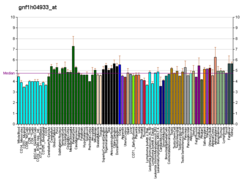Protein-coding gene in the species Homo sapiens
| SLITRK2 |
|---|
|
| Identifiers |
|---|
| Aliases | SLITRK2, CXorf2, SLITL1, SLIT and NTRK like family member 2, CXorf1, TMEM257 |
|---|
| External IDs | OMIM: 300561; MGI: 2679449; HomoloGene: 13054; GeneCards: SLITRK2; OMA:SLITRK2 - orthologs |
|---|
| Gene location (Human) |
|---|
 | | Chr. | X chromosome (human)[1] |
|---|
| | Band | Xq27.3 | Start | 145,817,829 bp[1] |
|---|
| End | 145,829,856 bp[1] |
|---|
|
| Gene location (Mouse) |
|---|
 | | Chr. | X chromosome (mouse)[2] |
|---|
| | Band | X|X A7.1 | Start | 65,692,924 bp[2] |
|---|
| End | 65,704,999 bp[2] |
|---|
|
| RNA expression pattern |
|---|
| Bgee | | Human | Mouse (ortholog) |
|---|
| Top expressed in | - internal globus pallidus
- caudate nucleus
- nucleus accumbens
- ganglionic eminence
- middle temporal gyrus
- amygdala
- putamen
- dorsolateral prefrontal cortex
- Brodmann area 9
- prefrontal cortex
|
| | Top expressed in | - trigeminal ganglion
- substantia nigra
- Region I of hippocampus proper
- dentate gyrus
- subiculum
- primary motor cortex
- habenula
- olfactory tubercle
- hippocampus proper
- cerebellar vermis
|
| | More reference expression data |
|
|---|
| BioGPS | 

 | | More reference expression data |
|
|---|
|
| Orthologs |
|---|
| Species | Human | Mouse |
|---|
| Entrez | | |
|---|
| Ensembl | | |
|---|
| UniProt | | |
|---|
| RefSeq (mRNA) | NM_001144003
NM_001144004
NM_001144005
NM_001144006
NM_001144007
|
|---|
NM_001144008
NM_001144009
NM_001144010
NM_032539 |
| |
|---|
| RefSeq (protein) | NP_001137475
NP_001137476
NP_001137477
NP_001137478
NP_001137480
|
|---|
NP_001137481
NP_001137482
NP_115928 |
| |
|---|
| Location (UCSC) | Chr X: 145.82 – 145.83 Mb | Chr X: 65.69 – 65.7 Mb |
|---|
| PubMed search | [3] | [4] |
|---|
|
| Wikidata |
| View/Edit Human | View/Edit Mouse |
|
SLIT and NTRK-like protein 2 is a protein that in humans is encoded by the SLITRK2 gene.[5][6][7]
Function
Members of the SLITRK family, such as SLITRK2, are integral membrane proteins with 2 N-terminal leucine-rich repeat (LRR) domains similar to those of SLIT proteins (see SLIT1; MIM 603742). Most SLITRKs, including SLITRK2, also have C-terminal regions that share homology with neurotrophin receptors (see NTRK1; MIM 191315). SLITRKs are expressed predominantly in neural tissues and have neurite-modulating activity.[7][6]
References
- ^ a b c GRCh38: Ensembl release 89: ENSG00000185985 – Ensembl, May 2017
- ^ a b c GRCm38: Ensembl release 89: ENSMUSG00000036790 – Ensembl, May 2017
- ^ "Human PubMed Reference:". National Center for Biotechnology Information, U.S. National Library of Medicine.
- ^ "Mouse PubMed Reference:". National Center for Biotechnology Information, U.S. National Library of Medicine.
- ^ Nagase T, Nakayama M, Nakajima D, Kikuno R, Ohara O (April 2001). "Prediction of the coding sequences of unidentified human genes. XX. The complete sequences of 100 new cDNA clones from brain which code for large proteins in vitro". DNA Research. 8 (2): 85–95. doi:10.1093/dnares/8.2.85. PMID 11347906.
- ^ a b Aruga J, Yokota N, Mikoshiba K (October 2003). "Human SLITRK family genes: genomic organization and expression profiling in normal brain and brain tumor tissue". Gene. 315: 87–94. doi:10.1016/S0378-1119(03)00715-7. PMID 14557068.
- ^ a b "Entrez Gene: SLITRK2 SLIT and NTRK-like family, member 2".
Further reading
- Bonaldo MF, Lennon G, Soares MB (September 1996). "Normalization and subtraction: two approaches to facilitate gene discovery". Genome Research. 6 (9): 791–806. doi:10.1101/gr.6.9.791. PMID 8889548.



















